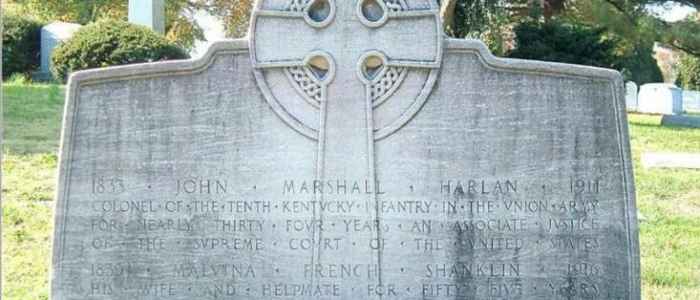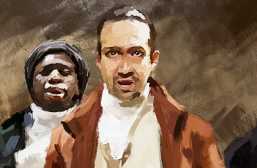An Inkwell’s Symbolic Influence on the Civil Rights Decisions of John Marshall Harlan

In Federalist No. 78, Alexander Hamilton assuages fears of an all-powerful judiciary by noting that the federal courts held no influence over “either the sword or the purse.” Over time, this phrase evolved to imply that although the Supreme Court may not possess the power of the purse or the sword, it does possess the so-called “power of the pen.” Perhaps no Supreme Court jurist has greater exemplified this power of the pen more than the “Great Dissenter,” John Marshall Harlan. This article traces the legacy of John Marshall Harlan by asking how the son of a Kentucky slaveholding family became seen as a legal advocate for Black civil rights in the United States. It concludes with a symbolic story of a simple inkwell that played two important parts in American legal history. This inkwell reminds us of the power that words and writing can have.
Background
Justice John Marshall Harlan of Kentucky served on the United States Supreme Court from 1877 to 1911, where he became known as “The Great Dissenter” for his dissents from the U.S. Supreme Court cases Plessy v. Ferguson and The Civil Rights Cases (among others). In Plessy, the Court infamously ruled that racial segregation in public accommodations did not violate the Thirteenth and Fourteenth Amendments so long as they were “separate but equal”. Harlan, however, wrote in dissent that “…in view of the Constitution, in the eye of the law, there is in this country no superior, dominant, ruling class of citizens. There is no caste here. Our Constitution is color-blind, and neither knows nor tolerates classes among citizens.” Plessy v. Ferguson, 163 U.S. 537 (1896).
One primary question has fascinated constitutional scholars about John Marshall Harlan. How did a White man born in 1833 in Kentucky to a slaveholding family become a champion of Black civil rights? (Przybyszewski 2003) 1 Harlan’s father, James Harlan (1800-1863), was a slaveholding attorney and Whig politician in Kentucky. Like his father, John Marshall Harlan (named for the great Chief Justice of the U.S. Supreme Court, John Marshall) opposed the immediate abolition of slavery in his early years. His early political career was allied with Whig politician Henry Clay, who supported gradual emancipation (Przybyszewskin 2003). During the Civil War, Harlan remained pro-Union in the border state of Kentucky, even raising his own Union Regiment, the Tenth Kentucky Infantry (Przybyszewski 2003). However, he continued to speak out against immediate emancipation of slaves throughout 1864-1867. By 1868, however, he had supported Ulysses G. Grant for President, joined the Republican Party, and formed a partnership in a law firm with Benjamin H. Bristow, then one of the only U.S. attorneys trying to enforce the Civil Rights Act of 1866 (Przybyszewski 2003).
He ran unsuccessfully for Kentucky governor as the Republican candidate in 1871 and 1875. By that time, he began proclaiming that he was glad that slavery was gone and that it had been evil. He was not one to shy away from his flip-flopping past on the issue of slavery, however. He once stated in a speech, “Let it be said that I am right rather than consistent” (Przybyszewski 2003).
Famous Dissents
Harlan’s nickname as “The Great Dissenter” on the U.S. Supreme Court is well-deserved. Harlan often dissented at a time in the Court’s history when such dissents were rare. To go against the majority took a measure of courage and tenacity. Harlan’s most famous dissent is from Plessy v. Ferguson, 163 U.S. 537 (1896), a Louisiana case involving Homer Plessy (who happened to be 1/8 Black). Plessy attempted to ride in the Whites-only railroad car and was arrested for violating Louisiana’s railroad segregation laws. He challenged the laws in court and the case made its way up to the U.S. Supreme Court. While the majority of the Court upheld the Louisiana statute, Harlan issued a powerful dissent castigating the Court for violating the 14th Amendment (which provided Blacks due process, privileges and immunities and equal protection under the law from states).
In my opinion, the judgment this day rendered will, in time, prove to be quite as pernicious as the decision made by this tribunal in the Dred Scott Case. It was adjudged in that case that the descendants of Africans who were imported into this country and sold as slaves were not included nor intended to be included under the word ‘citizens’ in the Constitution, and could not claim any of the rights and privileges which that instrument provided for and secured to citizens of the United States; that, at the time of the adoption of the Constitution, they were considered as a subordinate and inferior class of beings, who had been subjugated by the dominant race, and, whether emancipated or not, yet remained subject to their authority, and had no rights or privileges but such as those who held the power and the government might choose to grant them. Harlan, Dissent in Plessy v. Ferguson, 163 U.S. 537 (1896).
Harlan also dissented from the Civil Rights Cases, 109 U.S. 3 (1883) (where the Supreme Court struck down the Civil Rights Act of 1875); Berea College v. Kentucky, 211 U.S. 45 (1908) (where the state had banned interracial teaching in private schools and the Court decided that Berea College had to comply); and Giles v. Harris, 189 U.S. 475 (1903) (a case challenging the use of grandfather clauses to restrict voting to Blacks). Additionally, Harlan argued that the Constitution applied the same rights to citizens of newly acquired territories such as Philippines and Hawaii (see the Insular Cases).

Complicated Legacy
Harlan’s civil rights legacy is not without its blemishes. Harlan voted with the majority in Pace v. Alabama, 106 U.S. 583 (1883), which ruled that Blacks and Whites could not marry. This case was not reversed until 1966 in Loving v. Virginia, 388 U.S. 1. Scholars note that he made stereotypically disparaging remarks about Chinese immigrants in more than one of his opinions. He also repeatedly refused to address the issue of desegregation in public schools, though he had been happy to point out the incorrectness of such in other public accommodations (see Cumming v. Richmond County Board of Education, 175 U.S. 528 (1899)).
Why the Change?
Harlan’s transformation from reluctant slavery supporter to a fervent (albeit inconsistent) protector of civil rights for Blacks is a fascinating transition. A number of Harlan scholars have attempted to explain his changing views, as well as try to align them with his conflicting court decisions. Historian Linda Przybyszewski argues that many of Harlan’s views can be explained through the lens of White paternalism. She points to Malvina Harlan’s descriptions of John’s relationships with Blacks throughout his life. In her memoirs, Malvina’s descriptions are more of those of a “fatherly” type relationship rather than one based upon equality (See Przybyszewski 2003).

Certainly, his marriage to Malvina Shanklin Harlan had some influence upon his changing views. Malvina Shanklin was from the northern state of Indiana, which impacted her own anti-slavery views. The two were married for fifty-four years and Malvina’s memoir of her and her husband’s life together, Some Memories of a Long Life, offers glimpses into Harlan’s thoughts and beliefs on the civil rights of Blacks. (Malvina’s memoirs might not have even been published had it not been for current U.S. Supreme Court Justice, Ruth Bader Ginsburg, who had been researching the history of the women associated with the Supreme Court. The Library of Congress sent Justice Ginsburg the unpublished manuscript of Malvina Harlan. Ginsburg then helped to get the book published in 2003.) The book has become a valuable first-person account of John Marshall Harlan’s life, along with exposing the influence that his wife had upon their marriage. From reading their correspondence, there is no doubt that the two had a close marriage and that Malvina’s influence upon her husband was evident.
Other scholars point to the possibility that John Marshall Harlan had a half-brother of mixed race. Rumors alleged that his father, James Harlan, had fathered a child with a slave. This child, Robert James Harlan, was born in 1816 and was raised in the same household as the other children. He apparently had a successful life and remained close to the Harlan children, including John Marshall Harlan. DNA testing has been unable to confirm this rumor, but the possibility exists that John Marshall Harlan himself at least believed that he had a half-brother of mixed race. (See Przybyszewski 2003). This could certainly have influenced his pro-civil rights views for Blacks.
Another suggestion is that Harlan was simply a smart politician. He joined forces with the Republican Party when his Pro-Union Party fell apart. Some scholars argue that Harlan was always a dependable party man. Thus, if the Republican Party believed in civil rights for Blacks, so, too, did John Marshall Harlan (see Yarbrough 1995). 2 From a legal perspective, though, perhaps the most consistent explanation is that Harlan was simply a pro-national government Unionist who supported the basic intent of the Constitution. He often spoke on the belief that the national government’s role was to preserve the results of the Civil War. Further, he came to consider emancipation and the Civil War Amendments as the fulfillment of the promise of the Declaration of Independence (see Przybyszewski 2003). Probably most important, Harlan understood the passage of the 14th Amendment by the so-called Radical Republicans as clearly intended to protect former slaves and continued to fight for the original legislative intent of that amendment (see Plessy dissent). In many of his dissents, Harlan’s writing borders on the sarcastic, chastising southern states for trying to avoid the intent of the 13th (which granted former slaves citizenship) and 14th Amendments, which were clearly passed to protect Black citizens.
We boast of the freedom enjoyed by our people above all other peoples. But it is difficult to reconcile that boast with the state of the law which, practically, puts the brand of servitude and degradation upon a large class of our fellow citizens, our equals before the law. The thin disguise of “equal” {emphasis in the original} accommodations for passengers in railroad coaches will not mislead anyone, nor atone for the wrong this day done…. Harlan, Dissent in Plessy v. Ferguson.
Harlan’s writings indicate that he is insulted that these tactics, so clearly in violation of what he believed the purpose of the 13th and 14th Amendments to be, were so purposefully and outwardly provoking.
In a speech he made to a group of law students while serving on the Court, he once stated, “I am ready to say that if there is a Black man who can get ahead of me, I will help him along, and rejoice, and his progress in life does not excite my envy” (Przybyszewski 2003). Looking at his words and beliefs under a lens compared to Harlan’s contemporaries, these are not the words of your average White male at the turn of the 20th century. Harlan may not live up to our modern expectations of what a civil rights crusader should say, but he certainly was well ahead of his time and deserves credit for advocating for the civil rights of Blacks in an era when few other voices of his stature could be heard.
“An Inspiring Inkstand”
Perhaps no story is more symbolic to the “power of the pen” and the influence that writing can have upon society than the unique tale of an inkstand used by Harlan to write his famous dissent in the Civil Rights Cases. According to Malvina Harlan in her memoirs, John Marshall Harlan noticed the inkstand one day in the office of the Marshal of the Supreme Court. He asked the Marshal about the inkwell and was told that it once belonged to U.S. Supreme Court Justice Roger B. Taney and that Taney had used it when writing his many Supreme Court opinions. (Taney is infamously known to history as the author of the opinion in Dred Scott v. Sandford, 60 U.S. 393 (1857), where he wrote that Blacks “had for more than a century before been regarded as beings of an inferior order, and altogether unfit to associate with the White race either in social or political relations, and so far inferior that they had no rights which the White man was bound to respect, and that the Negro might justly and lawfully be reduced to slavery for his benefit. He was bought and sold, and treated as an ordinary article of merchandise and traffic whenever a profit could be made by it” (Dred Scott v. Sandford, 60 U.S. 393 (1857). Today, the case is seen by most constitutional scholars as the worst decision in U.S. Supreme Court history.)
On that fateful day, the Marshal gave the inkstand to Harlan, who took it home. Malvina writes that she “hid” the inkwell one day after overhearing her husband promise it to a distant relative of Taney’s, believing that her husband was the rightful owner of it. A few months later, the Court heard the Civil Rights Cases involving the constitutionality of the Civil Rights Act of 1873. Malvina notes in her memoirs that her husband was losing sleep over the case and would often get up during the middle of the night with great worry. Dissenting from a major Supreme Court case would take conviction and courage. She wrote that he seemed to “be in a quagmire of logic, precedent, and law” over the case (See Harlan 2003). 3
Malvina, ever the “subtle-hinting” wife, thought her husband needed a bit of “inspiration”, so she got the hidden inkstand out and cleaned it, sitting it on his desk to find. She wrote “Taney’s inkstand seemed to say to me, ‘I will help him’” (Harlan 2003). Upon her husband’s return, she told him, “I have put a bit of inspiration on your study table. I believe it is just what you need and I am sure it will help you” (Harlan 2003).
Malvina believed that the inkstand did inspire her husband to finish his great dissent from the Civil Rights Cases. She wrote:
It was, I think, a bit of ‘poetic justice’ that the small inkstand in which Taney’s pen had dipped when he wrote that famous (or rather infamous) sentence in which he said that ‘a Black man had no rights which a White man was bound to respect,’ should have furnished the ink for a decision in which the Black man’s claim to equal civil rights was as powerfully and even passionately asserted as it was in my husband’s dissenting opinion in the famous ‘Civil Rights’ case (Harlan 2003).

In his dissent in the Civil Rights Cases, John Marshall Harlan wrote that “It is not the words of the law, but the internal sense of it that makes the law; the letter of the law is the body; the sense and reason of the law is the soul.” To Harlan, that sense and reason included basic civil rights for Black Americans under the law. This was at a time when to say something in such a public manner was unheard of, if not dangerous. If Malvina Harlan is correct in believing that using Taney’s inkstand helped to finally inspire Harlan to take that courageous step, then its symbolism is truly unique in American legal history. The same inkstand used by Taney to say that the law offered ‘no rights to a Black man which a White man was bound to respect’ was later used by Harlan to write that “there cannot be, in this republic, any class of human beings in practical subjection to another class with power in the latter to dole out to the former just such privileges as they may choose to grant.” Civil Rights Cases, Harlan’s Dissent. These are powerful words written by a brilliant, if not enigmatic, man.
In the end, John Marshall Harlan would have the last laugh. His dissents have long been regarded as the correct interpretation under modern law. His dissent in Plessy v. Ferguson became precedent with the Court’s reversal of the “separate but equal” doctrine in Brown v. Board of Education, 347 U.S. 483 (1954), which finally mandated desegregation in all public accommodations, including public schools.
Words have meaning. To write is to wield power. The story of John Marshall Harlan and his symbolic inkstand demonstrate this power dramatically and effectively.
Works Cited
- Przybyszewski, Linda. 2003. Afterword. In Some Memories of a Long Life, 1854-1911. New York: Penguin Random House. ↩
- Yarbrough, Tinsley E. 1995. Judicial Enigma: The First Justice Harlan. Oxford: Oxford University Press. ↩
- Harlan, Malvina Shanklin. 2003. Some Memories of a Long Life, 1854-1911. New York: Penguin Random House. ↩
What do you think? Leave a comment.











Great article! Fascinating history about race relations here in the US- can’t wait to share it.
He is one of the better justices ever to occupy the bench.
This make for a useful introduction to Harlan’s achievements.
Great article!!!
What a great topic to focus on!
As one who has read probably a hundred books on the Supreme Court and it’s Justices (perhaps more), I can certainly say this study of Justice John Marshall Harlan is a fine addition to the field.
Harlan was a more well rounded and principled figure than many of the more popular justices during his time of service.
Thanks for sharing, I enjoyed reading this more than I thought.
I regularly discuss Harlan with my students. His dissent in Plessy v. Ferguson is what first piqued my interest in him.
Harlan is one of the greats.
He was remarkably out of place among his fellow justices.
Interesting article and well-supported.
Quite progressive for a southern former slaveowner…
Great post! Harlan is the most courageous Constitutionalist to ever grace the Supreme Court.
Fascinating piece. Thanks for the read.
This man was visionary and fearless on a Court of men who had little character.
Interesting study. The reputation of John Marshall Harlan has enjoyed considerable rehabilitation since his death.
A pioneer in difficult times as a country changed.
I so admire and respect John Marshall Harlan.
Fantastic article. Very good read.
Interesting stuff!
this is by far the best article i’ve ever read on the artifice.
I love your straightforward, clear concise writing style, fitting for historical inquiry. Well done.
I love your straightforward, clear, concise writing style, fitting for historical inquiry. Well done.
Well done. Thanks for your article. Was reading Notorious RGB’s book and stumbled across the story of Malvina, The Lady, in the story of the Lady and the Inkwell. Thanks
Well done. Thanks for your article. Was reading Notorious RBG’s book and stumbled across the story of Malvina, The Lady, in the story of the Lady and the Inkwell. Thanks
This is a good essay. I teach and have written on Constitutional law, and enjoyed it.
A good essay. I taught Constitutional Law for years and have written on it and this was enjoyable to read.